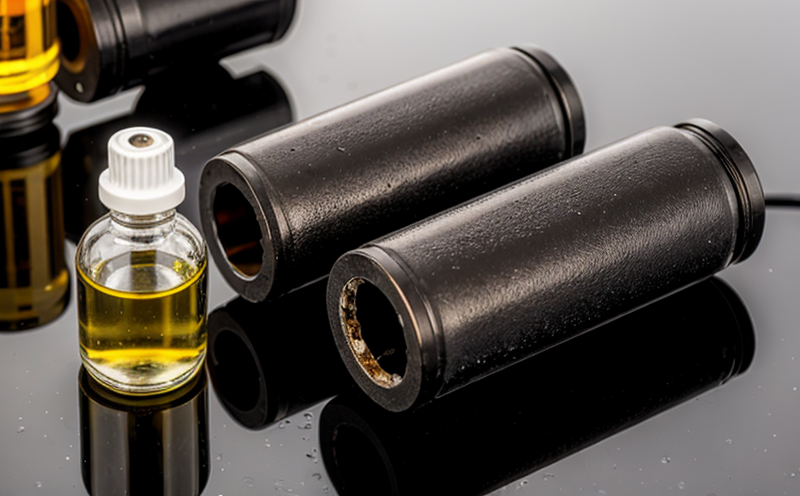ISO 9377 Petroleum Hydrocarbon Oil Index Test in Water
The ISO 9377 Petroleum Hydrocarbon Oil Index (OIL) test is a critical analytical procedure designed to measure the total petroleum hydrocarbon content present in water samples. This method is particularly useful for environmental monitoring, compliance with regulatory standards, and evaluating the impact of oil contamination on aquatic ecosystems.
The OIL index provides a quantitative assessment of the total oil and grease in water by measuring the amount of petroleum hydrocarbons that are extracted from the sample using an organic solvent. The process involves several steps including filtration, extraction, and analysis to determine the concentration of hydrocarbons present. This test is essential for industries involved in wastewater treatment, oil and gas operations, and environmental protection.
Understanding the significance of this test requires a basic knowledge of its application. The ISO 9377 method ensures that all petroleum hydrocarbon compounds are accounted for, which includes straight-chain alkanes, cycloalkanes, aromatic hydrocarbons, and their derivatives. This comprehensive approach allows laboratories to provide accurate assessments of pollution levels in water samples.
The methodology follows a standardized procedure outlined in the ISO 9377 standard. The process begins with the collection of an appropriate water sample, which is then filtered through a pre-defined filter size. Following filtration, the petroleum hydrocarbons are extracted using a solvent such as n-hexane or dichloromethane. After extraction, the organic layer containing the hydrocarbons is separated and analyzed for its concentration.
The analysis typically involves gas chromatography (GC) with flame ionization detection (FID). This technique allows for precise quantification of individual components within the petroleum fraction, providing detailed information about the nature and extent of contamination. The results are expressed as mg/L of total petroleum hydrocarbons in the water sample.
Accurate measurement of oil and grease content is crucial for ensuring compliance with environmental regulations such as those set forth by the United States Environmental Protection Agency (EPA) or similar bodies worldwide. Regular monitoring helps prevent potential harm to aquatic life, reduces liability risks associated with pollution incidents, and supports sustainable practices within industrial operations.
The ISO 9377 method is widely recognized for its reliability and accuracy in assessing petroleum hydrocarbon levels. By adhering strictly to the prescribed protocol, laboratories can generate consistent results that are comparable across different facilities or locations. This consistency enhances confidence in reported data and facilitates better decision-making processes related to pollution control and remediation efforts.
For industries reliant on water quality standards, this test plays an indispensable role in maintaining operational efficiency while minimizing environmental impacts. It serves as a cornerstone for effective management strategies aimed at reducing emissions into natural watersheds or treatment systems.
Industry Applications
- Oil and Gas Industry: Monitoring discharge from drilling platforms, refineries, and pipelines to ensure compliance with local regulations regarding hydrocarbon content in wastewater.
- Water Treatment Plants: Assessing the effectiveness of treatment processes by measuring residual oil levels post-treatment.
- Agricultural Operations: Evaluating irrigation runoff for potential contamination from agricultural chemicals that may have been inadvertently mixed with petroleum products.
- Petrochemical Facilities: Conducting periodic checks on discharge streams to verify compliance with emission limits specified in permits issued by regulatory authorities.
The ISO 9377 test is widely applicable across various sectors where there is a risk of hydrocarbon contamination entering water systems. Its versatile nature makes it suitable for use not only within the boundaries of industrial facilities but also extends to broader environmental monitoring programs aimed at protecting aquatic environments from pollution.
Eurolab Advantages
At Eurolab, we pride ourselves on providing clients with unparalleled expertise in executing ISO 9377 tests. Our team of highly qualified professionals ensures that every sample undergoes rigorous quality control measures to deliver accurate results consistently.
- Comprehensive Analytical Capabilities: Leveraging state-of-the-art instrumentation, including advanced GC-FID systems, allows us to provide precise measurements of petroleum hydrocarbons down to parts per million (ppm) levels.
- Trained Personnel: Our staff holds certifications relevant to environmental testing and possesses extensive experience in handling complex samples with diverse compositions.
- Prompt Reporting: Timely delivery of reports ensures that our clients receive actionable insights promptly, allowing for swift corrective actions if necessary.
- Dedicated Quality Assurance: Strict adherence to international standards guarantees reliability and reproducibility of results across multiple testing batches.
We understand the importance of delivering accurate data swiftly. With Eurolab, you can trust that your samples will receive the highest level of attention from start to finish, ensuring compliance with all relevant environmental regulations.





